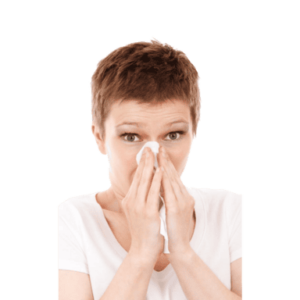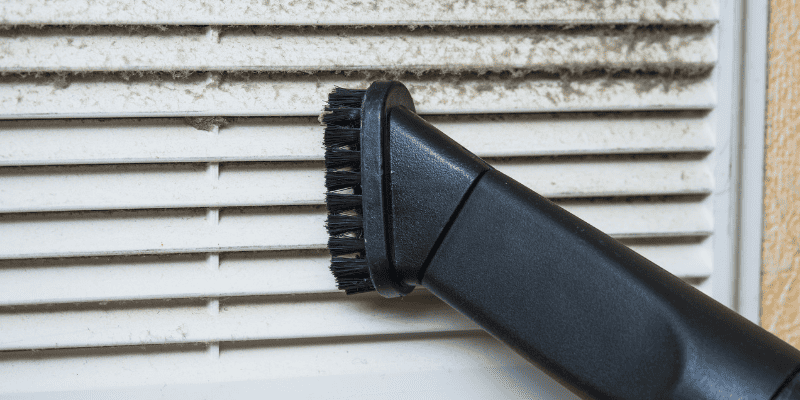When it comes to the inside of your home, there are a number of different things that can contribute to the accumulation of allergens in the home that will impact the air quality within this indoor space. If you are someone who experiences a dust allergy, the smallest traces of dust in the home can have your symptoms spiraling out of control. And even for those who are not afflicted with dust allergies, the dust can still significantly impact the air quality of your indoor living space.
When dust is present in your house, the components of the dust can have an affect not only on the air quality and on allergy symptoms, but it can also impact your lungs and overall health from exposure. The overall effect of dust will depend on several factors such as where you live, the amount of people living in your home, how frequently you clean the environment, and even other allergens present in the home like pets. Although dust have potentially hazardous effects, one thing is for sure, with the proper tips and methods you can easily remove the traces of dust in your home.
We are going to discuss where dust comes from inside your home, how it impacts those with dust allergies, and what is the best way to get rid of dust floating in the air of your home.
What Causes Dust in the House
 The dust has settled, and it has settled inside your home, on the surfaces and floating in the air. Dust can develop and be found in the home almost seemingly overnight, even after cleaning takes place within the environment. So, what exactly is dust? This allergen is defined as fine particles of solid matter that consist of particles in the atmosphere that come from a variety of sources including soil, dust lifted by the wind, volcanic eruption, and any type of pollution. The specific dust found in a home is usually compromised of different things found within the home such as pet dander, human skin cells, human hair, and food particles.
The dust has settled, and it has settled inside your home, on the surfaces and floating in the air. Dust can develop and be found in the home almost seemingly overnight, even after cleaning takes place within the environment. So, what exactly is dust? This allergen is defined as fine particles of solid matter that consist of particles in the atmosphere that come from a variety of sources including soil, dust lifted by the wind, volcanic eruption, and any type of pollution. The specific dust found in a home is usually compromised of different things found within the home such as pet dander, human skin cells, human hair, and food particles.
Pet Dander
When pets are present in the home, they will produce allergens into the air which are identified as ‘pet dander’. The dander are tiny flecks of skin that the animal sheds from their body, and this can even enter into the home of those without pets – as it can travel on clothing from those who do have pets in the home. When pet dander does settle into the environment and the air, it will collect dust and dust mites and increase the dust issue within the living space.
Dust Mites
A commonly associated allergen found in a home, dust mites are microscopic pests that occur naturally in the humid environment of a home. Dust mites are typically found in bedding, carpeting, and curtains as these areas will have a large amount of dead skin for the dust mites to feed onto and thrive. Along with dead skin, dust mites eat and grow on dust – so the more dust in the environment, the more dust mites you will have in this space.
Pollen
 Did you know that 60% of household dust comes from outside sources? One of these outside sources is every allergy sufferer’s worst nightmare, pollen. Pollen is a well-known allergen that can come inside your home through clothing, shoes, and even in your hair. When the pollen moves around your house it will settle on both the surfaces of your home and in the air. The pollen will eventually settle and develop into dust in the house.
Did you know that 60% of household dust comes from outside sources? One of these outside sources is every allergy sufferer’s worst nightmare, pollen. Pollen is a well-known allergen that can come inside your home through clothing, shoes, and even in your hair. When the pollen moves around your house it will settle on both the surfaces of your home and in the air. The pollen will eventually settle and develop into dust in the house.
Cockroaches
A surprising source of dust inside a home is insects such as cockroaches and their fecal matter droppings. Cockroaches are known allergens that could and potentially will aggravate allergy symptoms. When these insects infest your home and leave fecal droppings it will promote the growth of dust in the environment.
How Does Dust Form & What Does Dust Look Like
Have you ever heard of the white glove test or inspection? This is when someone uses a glove to trace over surfaces to see if dust and dirt appear, this is to indicate whether the surface or object is clean or not. Dust will be visible to humans, as it typically forms on surface and will appear as strains of dirt and other debris in a web like material. Dust is easily observed and rather easily cleaned from the surfaces – with the use of a rag and some moisture (cleaning supplies or water). Dust can also be identified in the air, it will look as particles in the air floating that is visible to the eye and upon inhalation you will most likely be alerted by coughing, sneezing, or other allergy-like symptoms.
House Dust Allergy
Dust and the dust mites that are triggered by the dust are known allergens that will cause an allergic reaction in many people who are plagued with allergies. Those individuals who are triggered by dust will experience symptoms in the presence of dust in a home, especially in high volumes. The severity of the symptoms will range from mild to severe – a mild case of dust allergies will strike the normal symptoms that an allergy sufferer will typically experience around allergens, whereas in cases where the dust is in high volumes it will introduce a persistent cough, sneezing, and congestion.
House Dust Allergy Symptoms
 For those who have or experience a dust allergy symptoms that may be triggered can include the following:
For those who have or experience a dust allergy symptoms that may be triggered can include the following:
- Sneezing
- Runny nose
- Nasal congestion
- Itchy, red or watery eyes
- Sore throat
- Postnasal drip
- Cough
- Facial pain and pressure
- Difficulty breathing
- Chest tightness
How to Get Rid of Dust Floating in the Air
Dust particles can be identified as irritants that can range in size and affect the health of individuals depending on the susceptibility of the individual and the amount of dust present in the environment. The size of dust particles is measured in microns and range from 10 microns in diameter to even smaller. The dangerous types of dust are those that are microscopic and that can enter into the body through the air and wreak havoc on a person’s lungs. This is why it is important to have protection from dust that is floating in your air.
An air purifier is a useful, and important device to have to filter the contaminants and allergens from your air to improve health and the quality of the indoor air. The EnviroKlenz Mobile Air System is a highly effective air purification device that uses a patented earth mineral technology to break down and neutralize the chemicals and odors from the air. This air system also contains a hospital-grade HEPA filter that will be able to capture allergens from the air that are larger than 0.3 microns in size – this will include dust that is found in the air.









